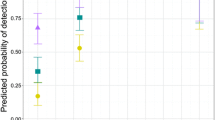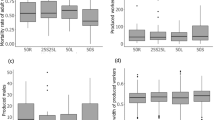Summary
Social organization is generally assumed to increase colony efficiency and survival; however, little quantitative information is available to support this assumption. Polymorphism is an important aspect of labor division in colonies of the fire ant, Solenopsis invicta. Our objective was to investigate the effect of fire ant polymorphism on brood production efficiency. We set up standardized polymorphic colonies with a full range of worker sizes and artificial monomorphic colonies that contained only small, medium or large workers respectively. Polymorphic colonies produced brood at about the same rate as colonies composed of only small workers (Fig. 2A). Colonies composed of only medium workers produced about 30% less brood, and colonies composed of only large workers produced little or no brood at all. This pattern was independent of colony size; however, smaller colonies (0.75 g, live weight) produced almost twice as much brood per gram of workers as larger colonies (3.0g). Additional experiments revealed that the size of workers in the artificial monomorphic colonies affected all stages of brood rearing. Large workers not only inhibited the development of early and late instar larvae (Fig 4), but also reduced the queen's oviposition rate (Fig. 3). Brood production efficiency on an energetic basis was determined by dividing the grams of brood produced per unit time by the energetic costs expended for the maintenance and production of each worker size class. Worker maintenance costs were estimated from respiration while production costs were determined from the caloric content of worker tissue divided by their average longevity. Worker respiration per milligram body weight decreased about 40% as body size increased (Fig. 5). Large workers lived about 50% longer than small workers (Fig. 6) and contained 9% more energy per milligram of tissue (Fig. 7). Energetic efficiency in polymorphic colonies was approximately 10% higher than in colonies composed of only small workers (Fig. 9). In other words, when food supplies are limiting, polymorphism may offer a slight advantage in brood production.
Similar content being viewed by others
References
Banks WA, Lofgren CS, Jouvenaz DP, Stringer CE, Bishop PM, Williams DF, Wojcik DP, Glancey BM (1981) Techniques for collecting, rearing, and handling imported fire ants. USDA and SEA, Adv Agricult Technol Southern Ser 21:1–9
Brian MV (1953) Brood-rearing in relation to worker number in the ant Myrmica. Physiol Zool 26:355–366
Brian MV (1956) Group form and causes of working inefficiency in the ant Myrmica rubra L. Physiol Zool 29:173–194
Brian MV (1972) Population turnover in wild colonies of the ant Myrmica. Ekol Polska 20:43–53
Davies SP (1966) A constant pressure respirometer for mediumsized animals. Oikos 17:108–112
Ettershark G, Whitford WG (1973) Oxygen consumption of two species of Pogonomyrmex harvester ants. (Hymenoptera: Formicidae). Comp Biochem Physiol 46 [A]:605–611
Elliott JM, Davison W (1975) Enegy equivalents of oxygen consumption in animal energetics. Oecologia (Berl) 19:195–201
Glancey BM, Stringer CE, Craig CH, Bishop PM, Martin BB (1973) Evidence of a replete caste in the fire ant Solenopsis invicta. Ann Entomol Soc Am 66:233–234
Glunn FJ, Howard DF, Tschinkel WR (1981) Food preference in colonies of the fire ant Solenopsis invicta. Insectes Soc 28:217–222
Greenberg L, Fletcher DJC, Vinson SB (in press) Differences in worker size and mound distribution in monogynous and polygynous colonies of the fire ant Solenopsis invicta Buren. J Kansas Entomol Soc
Haskins CP, Haskins EF (1980) Notes on female and worker survivorship in the archaic ant genus Myrmecia. Insectes Soc 27:345–350
Hays SB, Horton PM, Bass JA, Stanley D (1982) Colony movement of imported fire ants. J Ga Entomol Soc 17:266–274
Howard DF, Tschinkel WR (1981) Internal distribution of liquid foods in isolated workers of the fire ant, Solenopsis invicta. J Insect Physiol 27:67–74
Jennrich R, Sampson P (1979) General mixed model analysis of variance. In: Dixon WJ, Brown MB (eds) BMDP biomedical computer programs, P-series. University of California Press, Berkeley, pp 581–598
Jensen TF (1978a) An energy budget for a field population of Formica pratensis Retz. (Hymenoptera: Formicidae). Natura Jutl 20:203–226
Jensen TF (1978b) Annual production and respiration in ant populations. Oikos 31:207–213
Jorgensen CD, Porter SD (1982) Foraging behavior of Pogonomyrmex owyheei in southeast Idaho. Environ Entomol 11:381–384
Markin GP, Dillier JH, Collins HL (1973) Growth and development of colonies of the red imported fire ant, Solenopsis invicta. Ann Entomol Soc Am 66:803–808
Markin GP, O'Neal J, Dillier JH, Collins HL (1974) Regional variation in the seasonal activity of the imported fire ant, Solenopsis saevissima richteri. Environ Entomol 3:446–452
Michener CD (1964) Reproductive efficiency in relation to colony size in hymenopterous societies. Insectes Soc 11:317–341
Mirenda JT, Vinson SB (1979) A marking technique for adults of the red imported fire ant (Hymenoptera: Formicidae). Fla Entomol 62:279–281
Mirenda JT, Vinson SB (1981) Division of labour and specification of castes in the red imported fire ant Solenopsis invicta Buren. Anim Behav 29:410–420
Nielsen MG (1972) An attempt to estimate energy flow through a population of workers of Lasius alienus (Först) (Hymenoptera: Formicidae). Natura Jutl 16:99–107
Nielsen MG, Jensen TB (1977) Measurement of metabolism of worker ants by using the elimination of caesium-134. Oecologia (Berl) 30:209–214
O'Ncal J, Markin GP (1973) Brood nutrition and parental relationships of the imported fire ant Solenopsis invicta. J Ga Entomol Soc 8:294–303
Oster GF, Wilson EO (1978) Caste and ecology in the social insects. Princeton University Press, Princeton
Peacock AD, Baxter AT (1950) Studies in Pharaoh's ant, Monomorium pharaonis (L.). 3. Life history. Entomol Mon Mag 86:171–178
Peakin GJ, Josens G (1978) Respiration and energy flow. In: Brian MV (ed) Production ecology of ants and termites. IBP synthesis, vol 13. Cambridge University Press, Cambridge, pp 111–163
Petralia RS, Vinson SB (1978) Feeding in the larvae of the imported fire ant, Solenopsis invicta: behavior and morphological adaptations. Ann Entomol Soc Am 71:643–648
Petralia RS, Vinson SB (1979) Developmental morphology of larvae and eggs of the imported fire ant, Solenopsis invicta. Ann Entomol Soc Am 72:472–484
Porter SD (1983) Fast, accurate method of measuring ant head widths. Ann Entomol Soc Am 76:866–867
Porter SD, Jorgensen CD (1981) Foragers of the harvester ant, Pogonomyrmex owyheei: A disposable caste? Bchav Ecol Sociobiol 9:247–256
Porter SD, Tschinkel WR (1985) Fire ant polymorphism (Hymenoptera: Formicidae): factors affecting worker size. Ann Entomol Soc Am (in press)
Ricks BL, Vinson SB (1972) Changes in nutrient content during one year in workers of the imported fire ant. Ann Entomol Soc Am 65:135–138
Rogers L, Lavigne R, Miller JL (1972) Bioenergetics of the western harvester ant in the shortgrass plains ecosystem. Environ Entomol 1:763–768
Shoemaker DP, Garland CW, Steinfeld JI, Nibler JW (1981) Experiments in physical chemistry, 4th edn. McGraw-Hill, New York
Tschinkel WR, Howard DF (1978) Queen replacement in orphaned colonies of the fire ant, Solenopsis invicta. Behav Ecol Sociobiol 3:297–310
Wilson EO (1953) The origin and evolution of polymorphism in ants. Q Rev Biol 28:136–156
Wilson EO (1962) Chemical communication among workers of the fire ant Solenopsis saevissima (Fr. Smith) 1. The organization of mass-foraging. Anim Behav 10:134–147
Wilson EO (1968) Ergonomics of caste in the social insects. Am Nat 102:41–66
Wilson EO (1975) Sociobiology: the new synthesis. Belknap Press of Harvard University Press, Cambridge, Mass
Wilson EO (1978) Division of labor in fire ants based on physical castes (Hymenoptera: Formicidae: Solenopsis). J Kansas Entomol Soc 51:615–636
Wilson EO (1980) Caste and division of labor in leaf-cutter ants (Hymenopera: Formicidae: Atta). II. The ergonomic optimization of leaf cutting. Behav Ecol Sociobiol 7:157–165
Wilson NL, Dillier JH, Markin GP (1971) Foraging territories of imported fire ants. Ann Entomol Soc Am 64:660–665
Wood LA, Tschinkel WR (1981) Quantification and modification of worker size variation in the fire ant Solenopsis invicta. Insectes Soc 28:117–128
Author information
Authors and Affiliations
Rights and permissions
About this article
Cite this article
Porter, S.D., Tschinkel, W.R. Fire ant polymorphism: the ergonomics of brood production. Behav Ecol Sociobiol 16, 323–336 (1985). https://doi.org/10.1007/BF00295545
Received:
Accepted:
Issue Date:
DOI: https://doi.org/10.1007/BF00295545




